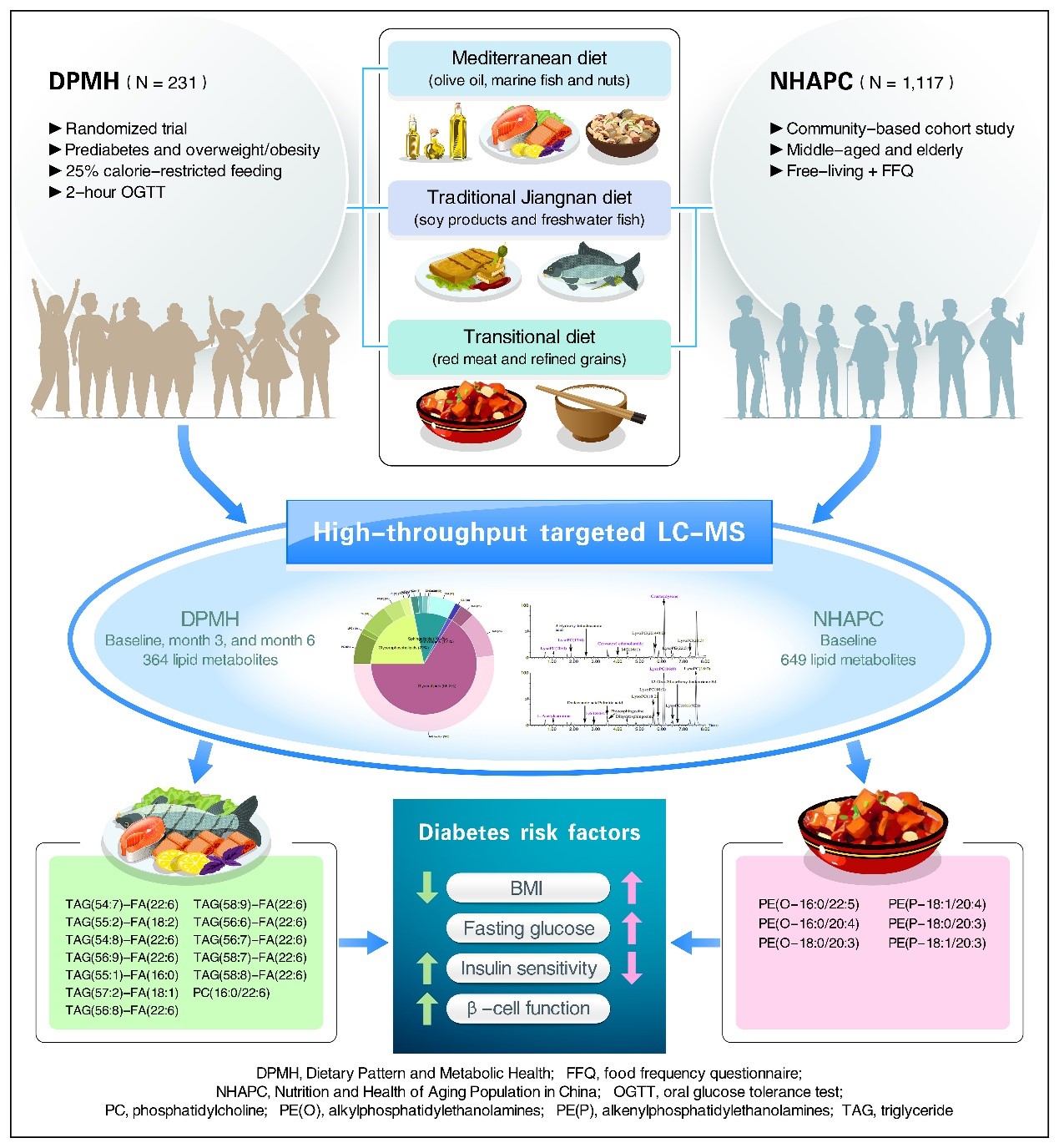Researchers Identify Links of Diet-related Lipidomic Signatures and Changed Type 2 Diabetes Risk
Prof. LIN Xu’s group from Shanghai Institute of Nutrition and Health (SINH) of the Chinese Academy of Sciences (CAS) collaborated with Prof. ZENG Rong’s group from Shanghai Institute of Biochemistry and Cell Biology, Center for Excellence in Molecular Cell Science of CAS identified several lipidomic signatures of Mediterranean diet, traditional Jiangnan diet, and transitional diet that reflected intakes of fish/red meat and was linked with modified diabetes risk in a previous randomized controlled feeding trial.
Dietary modification has been well recognized as a major strategy for preventing type 2 diabetes. In a previous 6-month isocaloric-restricted feeding trial, Prof. LIN Xu’s group from SINH and Prof. NING Guang’s group from Ruijin Hospital, Shanghai Jiao Tong University School of Medicine found that traditional Jiangnan diet, a habitual diet originating from Southeast China with plentiful vegetables, soy products, freshwater fish, and whole grains, had comparable benefits as Mediterranean diet in reduced body weight and improved glucose homeostasis; while a transitional diet characterized by red meat mainly pork and refined rice raised hypoglycemia risk.
However, it remains a challenge to illustrate the underlying mechanisms of specific food components in different dietary patterns and changed metabolic risks.
Researchers repeatedly analyzed the changes of 364 lipids among 231 participants with overweight and prediabetes during the 6-month trial, and combined the lipidomic database from the Chinese cohort (n=1,117). LUO Yaogan, the PhD student and Dr. SUN Liang from Prof LIN Xu’s group discovered that 26 lipid species altered across the three dietary patterns, including 12 triglyceride (TAG) fractions, five alkylphosphatidylethanolamines (PE(P)s), four alkylphosphatidylethanolamines (PE(O)s), four phosphatidylcholines (PCs), and one phosphatidylethanolamine. Of the aforementioned lipids, TAG fractions and PCs were associated with habitual fish intake, while PE(P)s and PE(O)s were associated with red meat intake.
Researchers also found that based on the module analysis and individual lipid analysis, TAG fractions and PCs reflecting fish intake were positively correlated with improvements of type 2 diabetes risks, including reduced body mass index (BMI), enhanced insulin sensitivity (Matsuda fraction index) and β-cell function (Disposition index); while PE(P)s and PE(O)s reflecting red meat intake were associated with deteriorated type 2 diabetes risks.
Overall, this study identified a number of novel lipid signatures and some of them could sensitively reflect the modifications of fish and red meat as components in the Mediterranean diet and/or traditional Jiangnan diet, while these signatures also linked with improved type 2 diabetes risk factors. Thus, the f2indings provided novel insights into optimizing dietary patterns.
This work entitled “Diet-related Lipidomic Signatures and Changed Type 2 Diabetes Risk in A Randomized Controlled Feeding Study with Mediterranean Diet and Traditional Chinese or Transitional diets” was recently published in Diabetes Care on July 18, 2023.
This research was funded by Strategic Priority CAS Project, Shanghai Municipal Science and Technology Major Project, and the National Natural Science Foundation of China.

Identification of fish/red meat related lipid signatures in different dietary patterns and their associations with changed type 2 diabetes risk factors. (Image provided by Dr. LIN Xu’s group)
Media Contact:
WANG Jin
Shanghai Institute of Nutrition and Health,
Chinese Academy of Sciences
Email: wangjin01@sinh.ac.cn
Web: http://english.sinh.cas.cn/
